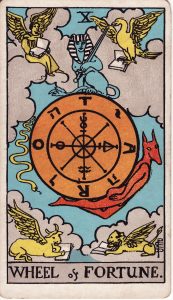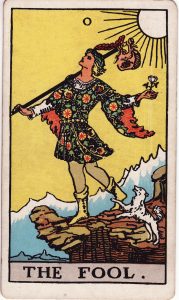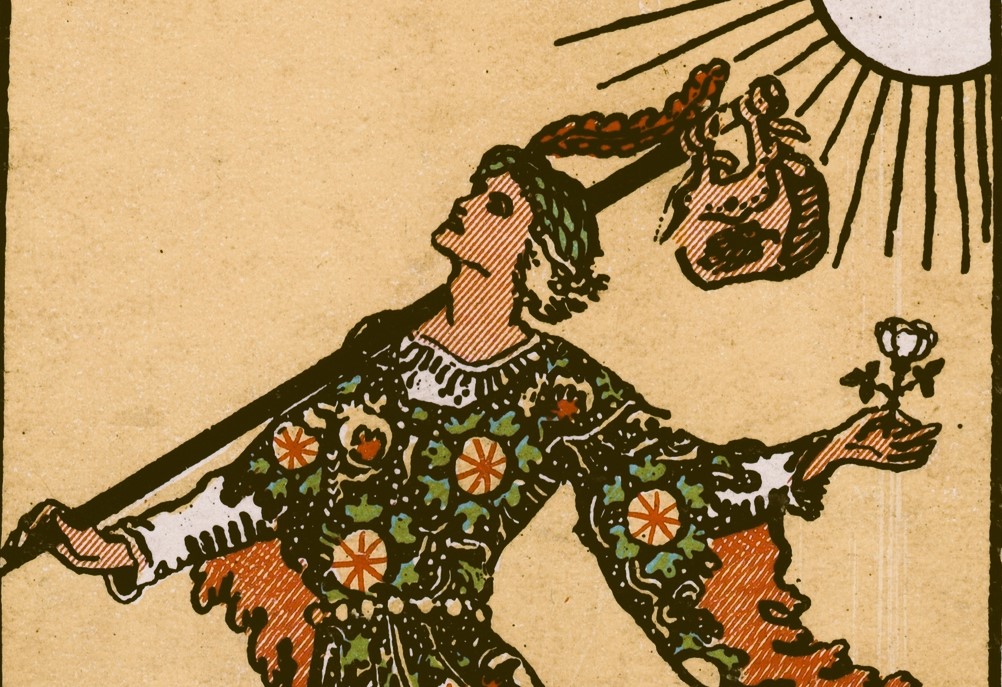For the uninitiated, a tarot deck contains 78 cards that are used for divinatory purposes. These cards are split into two main sections: the major and the minor arcanas. The major arcana consists of 22 named images, starting with 0 – The Fool, and ending with 21 – The World. It’s in the major arcana that we find notable cards such as Death and The Lovers.
The minor arcana, on the other hand,consists of four suits, each numbered ace-10 and followed by four court cards.
Eliphas Levi said that if you were locked in solitary confinement and the only book you had access to was a deck of tarot cards, you could, eventually, learn everything there was to know. Tarot, according to Levi, is a book of universal symbols that are intended to convey universal laws.
In the Fama Fraternitatis, the first publication by the so-called Brotherhood of the Rosy Cross, we are introduced to the Rota, some sort of thing that the brothers take instruction from, and that has a connection to God.
Occultists have made connections between taro and rota, hypothesizing that the rota was a kind of tarot deck. In fact, check out the Wheel of Fortune card to see that connection:

Start at the top and move clockwise and you have TAROT. Start at the bottom and move clockwise, you have ROTA.
And it’s all of these points, in addition to general Rosicrucian and tarot study over the years, that has led me to new ways of understanding the cards, and the Fool’s Journey, generally. I’d only heard of this in a fairly literal way for most of my tarot experience: The Fool is the main character of the tarot, and each successive major arcana card is a different phase of his life. I never really resonated with that idea, but something I took from it is the idea that the context of a card is important to its meaning. The Wheel of Fortune has its own straightforward meanings, but what more can we learn from it knowing its place between The Hermit and Justice?

Here we see the classic version of The Fool from the Rider tarot deck, designed by Arthur Edward Waite and illustrated by Pamela Coleman Smith.
The Fool is card number 0. Zero isn’t actually a number, but represents the absence of quantity. This places The Fool outside of the major arcana, and other occultists, like Levi, placed The Fool, still numbered 0, in different places within the major arcana to represent that fact. Waite, and others, saw this as a mistake, and moved The Fool to the very beginning of the deck. Zero comes before 1, and, because of that, contains all numbers (and no numbers).
Zero is no-thing. Immeasurable. Unfathomable. Infinite. It is freedom from every limitation.
No-thing contains everything, as it turns out. The Fool represents the vivifying life-blood of the universe. It is chi or qi or prana or energy. It is the force that causes atoms to attract and repel. It is the charge of an electron.
Rosicrucianism teaches us that this energy emenates from stars, in our case, the Sun. This subtle energy travels to our planet (and everywhere else the light from our star reaches) and enters our body through the air.
Breathing correctly is an essential skill in occultism for this very reason.
And so, we have on the card a white Sun in the top right corner. This is Pure Source, Absolute, Life-Power, Energy. The background of the card is yellow, a color that represents Air. Thus, life-giving energy comes from the sun and infuses the air here on earth, giving life to all creatures and plants.
In fact, “fool” comes from the Latin “follis” meaning wind-bag. It also means “bellows.”
The Fool himself is a personified representation of this life-giving energy once it has interacted with this material reality. And he waltzes right off a cliff because he isn’t a man. He isn’t a god or a deity or even some mythical creature. He is, instead, life-energy flowing indiscriminately across creation. HE is the energy embodying all the other figures throughout the major arcana.
The Fool is the base, the foundation, the limitless expanse from which the rest of the cards materialize.
So many cards share a similar yellow background. Is this a clue to connections? Or maybe a clue to qabalistic meaning?
The numerals as we know them (0-9) represent concepts. And the concept of nothing, of no-thing, is The Fool.
Interpreting this card, I always spoke about a person being eager to start a new journey, but maybe letting that excitement cloud their vision. Now, I see that The Fool isn’t “foolish” at all, but actually contains a type of wisdom that transcends right and wrong, moves past concepts of morals or ethics. The Fool is.
If The Fool comes up for you in a reading, remember that he only appears foolish to us, to those of us who cannot understand his Divine Will. It is a reminder to trust what you are unable to comprehend, and it’s a directive to guide The Fool in such a way as to more balance our existence.
The world is good to live in if you know how.

Leave a Reply